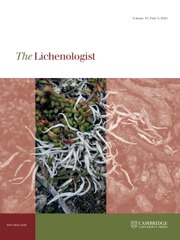Article contents
Visualizing usnic acid with anisaldehyde reagent
Published online by Cambridge University Press: 12 December 2024
Abstract
The pale yellowish tint of usnic acid in a lichen thallus itself is a commonly used character in identification keys, particularly in the genus Cladonia. Furthermore, the presence of usnic acid is phylogenetically significant in numerous groups of lichens. While the distinctive colour of usnic acid is readily visible when present in high concentrations, it is commonly problematic to discern when in low to moderate concentrations. We explored the use of an anisaldehyde reagent for visualizing usnic acid. Using both usnic acid-containing Cladonia samples and pure usnic acid, this reaction quickly yields a bright magenta colour on HPTLC and TLC plates after heating and directly with crude acetone extracts on glass slides heated with a lighter. The same magenta product was observed whether or not the usnic acid was accompanied by barbatic, fumarprotocetraric, psoromic, squamatic or thamnolic acids, each of which alone did not produce any colour with anisaldehyde reagent. However, the merochlorophaeic acids in C. albonigra also produced a red reaction. Analysis by high resolution LC-MS of the reaction mixture between anisaldehyde and usnic acid revealed several ions at m/z 477.1586 ([M+H]+, C27H25O8) and 463.1385 ([M+H]+, C26H23O8), respectively, consistent with aldol condensation of usnic acid and p-anisaldehyde.
Information
- Type
- Standard Paper
- Information
- The Lichenologist , Volume 56 , Special Issue 5: A Special Issue dedicated to Professor Teuvo Ahti , September 2024 , pp. 193 - 200
- Copyright
- Copyright © The Author(s), 2024. Published by Cambridge University Press on behalf of the British Lichen Society
References
- 1
- Cited by


